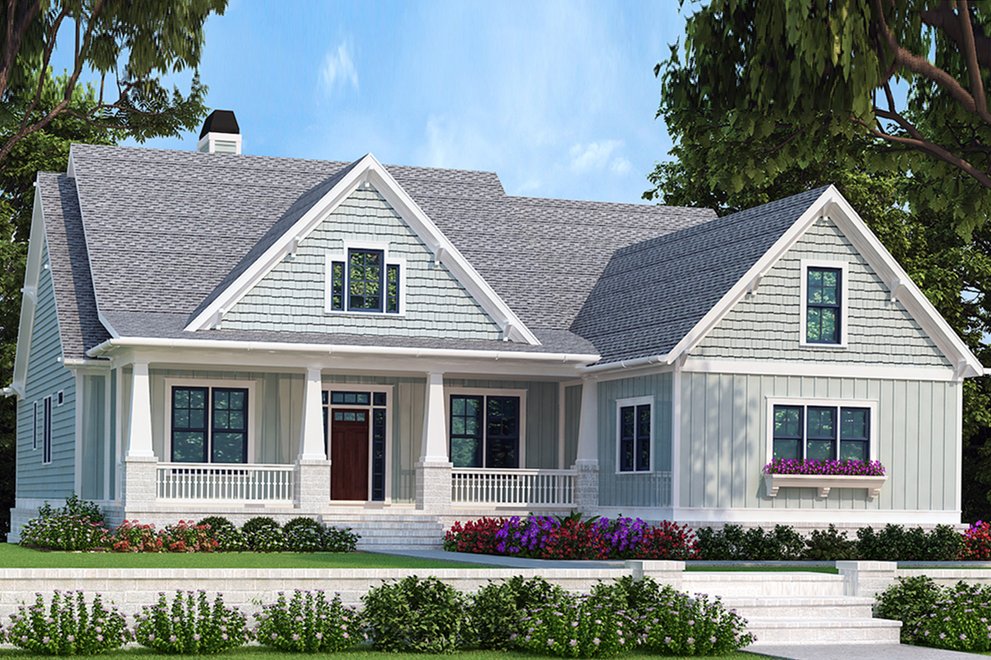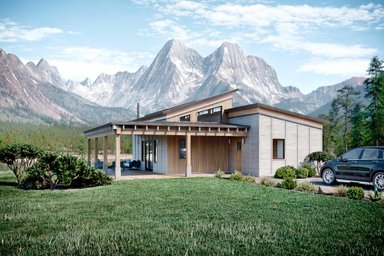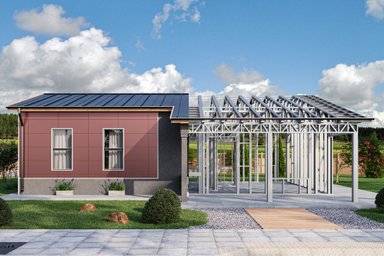Back in the day, many of the oldest homes in this country
could have achieved the net-zero water designations that are cherished today. Rainwater
was captured in cisterns. Wells provided drinkable water. An outhouse served as a toilet. These days, with different social norms and regulatory parameters
in effect, the approach to net-zero water must be different. “We’re trying to
develop a solution that allows people to enjoy the convenience of indoor
plumbing,” jokes Eric Bowler of Whirlpool, which has teamed with Kohler Cos. to
do a net-zero demonstration home near the Purdue University campus in West
Lafayette, Indiana.
Bowler presented on the ReNEWW house, a 1920s bungalow, at Greenbuild 2015 (photo at the top of this post). Based on presentations at Greenbuild, the annual conference on sustainable building, net-zero energy homes are almost passé. But homes that harvest all the water occupants need? They remain illusive. Nevertheless, the few projects under development provide a valuable road map toward net-zero water use. Bowler and his team first sought to minimize water consumed by the home’s occupants. That would be initial focus for a new home as well, since it reduces the investment otherwise required in new equipment. The team replaced the home’s old fixtures, faucets, and water-consuming appliances. They added a new dishwasher from KitchenAid that removes food particles during the wash cycle, new toilets that use one-quarter the water of old ones, and water-conserving faucets and showerheads. They also re-plumbed the house to eliminate leaks, which can be a major source of water loss. Together, the moves should reduce water consumption by 60 percent, the researchers believe.
The next step was to capture rainwater from the roof, just like people did 140 years ago. An engineering analysis showed that, given local precipitation patterns, the 1,600-square-foot roof should generate about 34,000 gallons of water per year, about one third of what the average household consumes in a year. The rainwater flows into two 1,500-gallon storage tanks – after roof debris is diverted. To make it potable, the water is first filtered, then disinfected by exposure to ultraviolet light. It is ultimately directed to faucets and showerheads within the home.
Then came analyzing the potential for greywater recycled from sinks and showers to flush toilets. Researchers found that the shower and lavatory would produce slightly more water than the low-flush toilets would need. Extra greywater was dedicated to supplement the needs of the washing machines. One benefit of the greywater system is that potable water from the water company isn’t used for toilets, where it isn’t really needed. And toilets are the biggest users of water within the home. The group decided not to bother with black water produced by toilets; it is sent to the public sewage system. Theoretically, composting toilets could be used to manage blackwater, with the compost used for a garden. But few homeowners elect to go that route. Obtaining regulatory approval can be difficult.
A prototype system from CleanBlu processes the greywater. It is first treated to metabolize contamination then put through an ozonation stage, before it is stored then distributed through the greywater supply system. The greywater system can provide 450 gallons per day. The only maintenance required is a twice-yearly replenishment of microbial concentrate. Bower can monitor the greywater system and water use in the house through an app on his smart phone. He expects that collecting rainwater and managing greywater will provide 99 percent of the potable water needed and reduce sewage effluent up to 60 percent.
A team at the University of Michigan is working on a similar project to retrofit an old Ann Arbor Victorian to net-zero water use. They ran into an obstacle, though, when they tested water running off the roof: lead. A new metal roof had to be installed, along with a rooftop rainwater collection system that includes filtering and disinfection. The system provides pressurized water to fixtures throughout the house. A greywater treatment and storage system, from Nexus eWater, will treat water from the bath, shower, and bathroom sinks. It will be used in the toilets, washing machine, and outdoor spigots.
Water from the kitchen sink and dishwasher was classified by local government as blackwater because of a high concentration of organic compounds, including nitrogen and phosphorous. It is treated then moved to wetland constructed on the property. The team gained approval to treat toilet waste in a basement composting unit.
New homes that meet the net-zero water criteria are few and far between. One, a prototype modular home,
Nexushaus, is designed with a breezeway canopy to collect more than 17,000 gallons of water annually in
Austin, Texas. The water is treated and stored in tanks under a deck. Rainwater supplies all the potable water
needs of the home – drinking, bathing, clothes, and dish washing -- although the home will still be connected to the municipal water supply for backup. A system recycles and filters greywater from the bathroom sink, shower, and clothes washer to water the lawn and garden.
More net-zero water homes are likely to appear on the national radar in coming years due to the emergence of a rigorous new certification program, the Living Building Challenge. Unlike green building programs that try to minimize a home’s environment impact, the Living Building Challenge seeks to eliminate it altogether. To earn a certificate, homes must be net-zero in their use of energy and water. Certification is tough because it requires a year’s worth of real data, as opposed to a design computation. Researchers working on the demonstration homes in West Lafayette and Ann Arbor have adopted Living Building Challenge certification as a project goal.
Bowler presented on the ReNEWW house, a 1920s bungalow, at Greenbuild 2015 (photo at the top of this post). Based on presentations at Greenbuild, the annual conference on sustainable building, net-zero energy homes are almost passé. But homes that harvest all the water occupants need? They remain illusive. Nevertheless, the few projects under development provide a valuable road map toward net-zero water use. Bowler and his team first sought to minimize water consumed by the home’s occupants. That would be initial focus for a new home as well, since it reduces the investment otherwise required in new equipment. The team replaced the home’s old fixtures, faucets, and water-consuming appliances. They added a new dishwasher from KitchenAid that removes food particles during the wash cycle, new toilets that use one-quarter the water of old ones, and water-conserving faucets and showerheads. They also re-plumbed the house to eliminate leaks, which can be a major source of water loss. Together, the moves should reduce water consumption by 60 percent, the researchers believe.
The next step was to capture rainwater from the roof, just like people did 140 years ago. An engineering analysis showed that, given local precipitation patterns, the 1,600-square-foot roof should generate about 34,000 gallons of water per year, about one third of what the average household consumes in a year. The rainwater flows into two 1,500-gallon storage tanks – after roof debris is diverted. To make it potable, the water is first filtered, then disinfected by exposure to ultraviolet light. It is ultimately directed to faucets and showerheads within the home.
Then came analyzing the potential for greywater recycled from sinks and showers to flush toilets. Researchers found that the shower and lavatory would produce slightly more water than the low-flush toilets would need. Extra greywater was dedicated to supplement the needs of the washing machines. One benefit of the greywater system is that potable water from the water company isn’t used for toilets, where it isn’t really needed. And toilets are the biggest users of water within the home. The group decided not to bother with black water produced by toilets; it is sent to the public sewage system. Theoretically, composting toilets could be used to manage blackwater, with the compost used for a garden. But few homeowners elect to go that route. Obtaining regulatory approval can be difficult.
A prototype system from CleanBlu processes the greywater. It is first treated to metabolize contamination then put through an ozonation stage, before it is stored then distributed through the greywater supply system. The greywater system can provide 450 gallons per day. The only maintenance required is a twice-yearly replenishment of microbial concentrate. Bower can monitor the greywater system and water use in the house through an app on his smart phone. He expects that collecting rainwater and managing greywater will provide 99 percent of the potable water needed and reduce sewage effluent up to 60 percent.
A team at the University of Michigan is working on a similar project to retrofit an old Ann Arbor Victorian to net-zero water use. They ran into an obstacle, though, when they tested water running off the roof: lead. A new metal roof had to be installed, along with a rooftop rainwater collection system that includes filtering and disinfection. The system provides pressurized water to fixtures throughout the house. A greywater treatment and storage system, from Nexus eWater, will treat water from the bath, shower, and bathroom sinks. It will be used in the toilets, washing machine, and outdoor spigots.
Water from the kitchen sink and dishwasher was classified by local government as blackwater because of a high concentration of organic compounds, including nitrogen and phosphorous. It is treated then moved to wetland constructed on the property. The team gained approval to treat toilet waste in a basement composting unit.
New homes that meet the net-zero water criteria are few and far between. One, a prototype modular home,
Nexushaus, is designed with a breezeway canopy to collect more than 17,000 gallons of water annually in
Austin, Texas. The water is treated and stored in tanks under a deck. Rainwater supplies all the potable water
needs of the home – drinking, bathing, clothes, and dish washing -- although the home will still be connected to the municipal water supply for backup. A system recycles and filters greywater from the bathroom sink, shower, and clothes washer to water the lawn and garden.
More net-zero water homes are likely to appear on the national radar in coming years due to the emergence of a rigorous new certification program, the Living Building Challenge. Unlike green building programs that try to minimize a home’s environment impact, the Living Building Challenge seeks to eliminate it altogether. To earn a certificate, homes must be net-zero in their use of energy and water. Certification is tough because it requires a year’s worth of real data, as opposed to a design computation. Researchers working on the demonstration homes in West Lafayette and Ann Arbor have adopted Living Building Challenge certification as a project goal.






